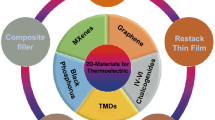Abstract
A systematic investigation of the thermal conductivity of zigzag graphene nanoribbons (ZGNRs) doped with nitrogen and containing a vacancy defect was performed using reverse nonequilibrium molecular dynamics (RNEMD). The investigation showed that the thermal conductivity of the ZGNRs was significantly reduced by nitrogen doping. The thermal conductivity dropped rapidly when the nitrogen doping concentration was low. Also, the presence of a vacancy defect was found to significantly decrease the thermal conductivity. Initially, as the vacancy moved from the heat sink to the heat source, the phonon frequency and the phonon energy increased, and the thermal conductivity decreased. When the distance between the vacancy in the ZGNR and the edge of the heat sink reached 2.214 nm, tunneling began to occur, allowing high-frequency phonons to pass through the vacancies and transfer some energy. The curve of the thermal conductivity of the ZGNRs versus the vacancy position was found to be pan-shaped, with the thermal conductivity of the ZGNRs controlled by the phonon. These findings could be useful when attempting to control heat transfer on the nanoscale using GNR-based thermal devices.








Similar content being viewed by others
References
Novoselov KS, Geim AK (2004) Science 306:666
Berger C, Song Z, Li X, Wu X, Brown N (2006) Science 312:1191
Ghosh S, Callizo L (2008) Appl Phys Lett 92:151911
Guo Z, Dier Z, Xin-Gao G (2009) Appl Phys Lett 95:163103
Chien S-K, Yue-Tzu Y, Chaó-Kuang C (2011) Appl Phys Lett 98:033107
Shao Y, Sheng Z, Mark HE (2010) J Mater Chem 20:7491
Dacheng W, Yunqi L, Yu W (2009) Nano Lett 5:1752
Xinran W (2009) Science 324:768
Ying W, Yuyan S (2010) ACS Nano 4:1790
Florian Muller-Plathe J (1997) Chem Phys 106:6082
Ning W, Langqing X, Hui-Qiong W (2011) Nanotechnology 22:105705
Jiuning H, Xiulin R, Chen YP (2009) Nano Lett 7:2730
Luks JR, Zhong H (2007) J Heat Transfer 129:705
Jiang J-W, Lan J, Jian-Sheng W (2010) J Appl Phys 107:054314
Donald WB, Olga AS (2002) J Phys Condens Matter 14:783
Tersoff J (1989) Phys Rev B 39:5566
Katsuyuki M, Craig F (2000) J Appl Phys 38:L48
Nika DL, Pokatilov EP (2009) Phys Rev B 79:155413
Hu J, Stephen S, Ajiit V, Xiulin R (2010) Appl Phys Lett 97:133107
Yang N, Nianbei L, Lei W (2007) Phys Rev B 76:020301
Abramson AR, Tien C-L, A. Majumdar (2002) ASME J Heat Transfer 124:963
Chien S-K, Yue-Tzu Y, Cháo-Kuang (2010) Phys Lett A 374:4885
Chen J, Zhang G, Li B (2009) Appl Phys Lett 95:073117
Baowen L, Lan J, Wang L (2005) Phys Rev Lett 95:104302
Yang P, Li X, Yang H, Wang X, Tang Y, Yuan X (2013) Appl Phys Mater Sci Process. doi:10.1007/s00339-013-7607-5
Acknowledgments
The authors would like to acknowledge the support of the National Natural Science Foundation of China (61076098, 51275182), the support of the Jiangsu Province Science Foundation for Youths, the Innovative Science Foundation for Graduate Students of Jiangsu Province (CXZZ13_0655, CXLX12_0622), and the Special Natural Science Foundation for the Innovative Group of Jiangsu University during the course of this work.
Author information
Authors and Affiliations
Corresponding authors
Rights and permissions
About this article
Cite this article
Yang, H., Tang, Y., Gong, J. et al. Influence of doped nitrogen and vacancy defects on the thermal conductivity of graphene nanoribbons. J Mol Model 19, 4781–4788 (2013). https://doi.org/10.1007/s00894-013-1937-2
Received:
Accepted:
Published:
Issue Date:
DOI: https://doi.org/10.1007/s00894-013-1937-2




